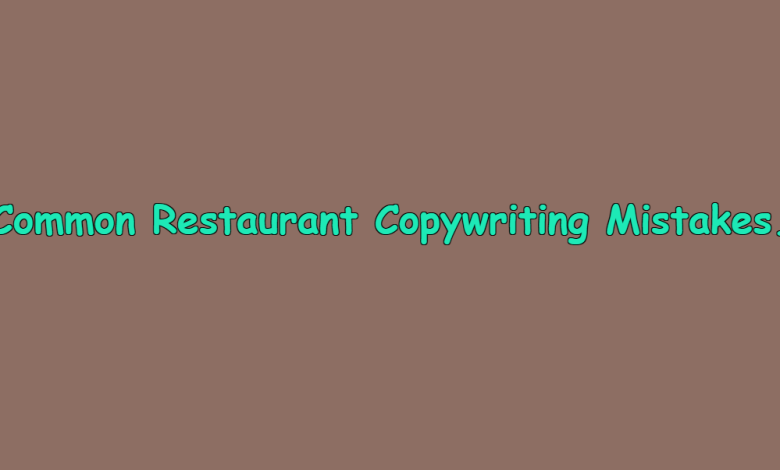Common Restaurant Copywriting Mistakes.

6 Common Restaurant Copywriting Mistakes (and How to Fix Them)
One of the hats that restaurant owners often find themselves wearing is that of copywriter. With limited management staff at their disposal, it’s just one of the many jobs that falls to the top. But since restaurant owners are generally not writers by trade, there are some common copywriting mistakes that we see over and over again.
Here are 6 common restaurant copywriting mistakes, and what you can do to fix them.
1. Typ0s
Crap!
I meant “typos”.
Once you’ve been staring at the same document for too long, everything starts to run together and it becomes easy to miss little errors. They’re easy to make, and autocorrect doesn’t always catch them. And they just look so sloppy.
Of course, typos are not limited to restaurant owners. But restaurants often have no office staff, no one to sit at a desk and pore over every word, comma, and period.
How to fix it
Get a second pair of eyes on everything you write, especially if it’s going to be in print. Think menus, t-shirts, and signs — anything that will be expensive to redo.
Ask someone with good attention to detail to go over it with a magnifying glass. You’re looking for teh instead of the, i instead of I, and $8,00 instead of $8.00. A fresh set of eyes on your work will be invaluable in helping you to catch these little mistakes.
2. Usage errors
You know the difference between they’re, their, and there, but when you’re in the flow of writing, it can be easy to pull the wrong one out of mental grab-bag.
Online grammar warriors may claim they’ve never done it, but they’re lying.
JUST IN CASE you need a refresher on a few of the most common homonyms:
They’re vs. their vs. there
- They’re – they are. They’re so fast at this restaurant!
- Their – shows possession. That’s their table.
- There – Shows a place or location. The bathroom is over there.
Too, to, two
- Too – also. I’m hungry, too.
- To – approaching or expressing motion. Let’s go down to Restaurant Depot.
- Two – the number 2. I’ll have two tacos, please.
Your, you’re, yore
- Your – shows possession. Here is your dinner.
- You’re – a contraction of “you are”. You’re the best.
- Yore – back in the day. Grandma longs for days of yore.
It’s, its, its’
- It’s – a contraction of it is. It’s nice to meet you.
- Its – expressing ownership. The dog was carried in its crate.
- Its’ – this is not a word. Don’t use it. If it’s not a contraction for “it is”, you use “its”.
Customer vs. costumer
This isn’t actually a homonym, but I see customer misspelled as “costumer” so often that I think it deserves an honorable mention. A customer is someone who comes into your restaurant for a tasty meal. A costumer designs costumes, possibly for movies or plays.
This happens so often that look what happens when I type “costumer” into Google:
Even GOOGLE doesn’t know what I mean.
A customer can be in the market for costumes. Then they’re a costume customer. If they’re looking for something unique, they could be a custom costume customer. English is fun.
How to fix it
Well first, share this article with everyone you know, so they too can absorb this wisdom.
Then, download Grammarly (or something similar Grammica Grammar Check ). Grammarly is pretty good about catching these usage errors — although it’s not perfect.
You can use it Grammarly on Google Chrome, Firefox, and Safari. What’s especially nice about it is that as a free browser extension, it will catch your errors wherever you’re typing online — Facebook, email, Google Docs, Yelp, wherever.
Again, it’s not perfect, and won’t be able to take the place of a thorough proofread. But it will help you catch a lot of these little errors.
3. Not sounding like a person
Back before the internet, restaurants didn’t have to talk directly to their customers in writing very often. They had to write a menu and maybe do some print advertising or direct mail, and that was about it.
Then the internet happened, and now you need a website, social media content, maybe some press releases, email newsletters…and somehow, when people start to write “as a business” they completely forget how human beings talk.
Instead of using, they utilize. Instead of eating, they have a dining experience. Instead of tasks, they have action items.
Who talks like that? You’re one “synergy” away from being completely incomprehensible.
How to fix it
Read it out loud. Do you sound like you?
If it sounds stilted or a bit robotic, take another stab at it. Pretend you’re talking to a friend. How would you say it to them? Try writing it like that.
4. Inconsistency
Menus are a restaurant-specific minefield of copywriting inconsistencies.
And vs. &
With vs. w/
$6.00 vs. $6
Do you want a period at the end of your entrée descriptions or not? It doesn’t really matter, but if you use a period at the end of one, you should use a period at the end of them all.
Menus are notorious for this kind of error. No, these little copywriting mistakes are not going to make or break your restaurant. But they still look careless and unprofessional.
How to fix it
Grab a copy of your menu and a few different colored pens or highlighters. Now start reading. Every time you see something that could be written more than one way, circle it.
Does your menu read “Served w/ fries”? Great. Now find every single place where it says with, and make sure it’s w/.
Do you have any special sauces or condiments? Make sure they’re spelled the same and capitalized the same every time they appear.
This can be especially taxing with really long wine or beer lists. But taking the time to make sure that California is CA consistently or that the price is listed before the ABV throughout the menu will make your restaurant look that much more polished.
5. Not calling out your USP
See, I said to write like a person, and now I’m using abbreviations like USP.
Your USP is your Unique Selling Point. What makes your restaurant special? What makes your bar unique?
Every place should have some kind of special draw that lures customers through your doors instead of to the bar down the street. You should be using that USP to position yourself as the leader of your niche.
But too many restaurants ignore this. They sell burgers, so they call themselves a bar and grill and put some burgers on the menu. What’s special about your burgers or the way you make them? Why should I spend my burger budget with you instead of at Whataburger?
How to fix it
If you’re honestly not sure what your USP is, ask the people who know best — your customers. They’ll tell you why they come to your bar or restaurant, and help you narrow it down.
Do you have the best beer selection this side of the Mississippi? Then you should be talking about it. Did your fried chicken once make a grown man cry? Then you should be talking about it.
Don’t assume that potential customers know what makes you special. If you don’t tell them, no one will.
6. Not enough content
Another common restaurant copywriting mistake is not including enough content on their websites.
When Google (or other search engines) are ranking your website, one of the factors the algorithm takes into account is how many words there are on your site. Google considers less than 300 words to be “light” content, meaning the algorithm doesn’t consider it very useful to the searcher. So a website with just a restaurant name, address, and pdf of the menu isn’t going to help you much.
Now, this is not the only factor that affects rankings. Far from it. In fact, Google uses about 200 different ranking factors when determining where your website shows up in a search. But having a little extra content can give your site a boost.
How to fix it
First of all, don’t upload your menu as a pdf or image to your website. Google generally does count this text, but it can run into problems. Plus, customers hate having to download something just to see your menu. Put the menu ON your website, like so:
After that, think about what other information your guests might like. Don’t overcomplicate your website, but an “About” section with your restaurant’s story might be interesting.
Or if you make a particularly unique or regional cuisine, you could share some knowledge about that. For example, if you make Northern Thai food, write a few paragraphs about what makes the food from this region different than from the rest of Thailand.
To Wrap Up
If you’re rushing through your copy and content and assuming it’s good enough, you’re doing yourself a disservice.
Words are the link between your product and your customer. They’re what turn a potential diner into an actual one, teeing up your food and service to knock it out of the park. So give your copy the attention it deserves, instead of treating it as an afterthought.





